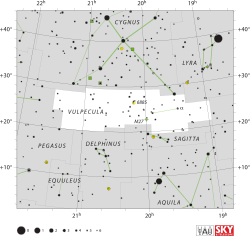HD 189733 X-ray
The researchers determined that at least 1,000 tons of gas was leaving the planet's atmosphere every second. The hydrogen atoms were racing away at speeds greater than 300,000 mph. The findings will appear in an upcoming issue of the journal Astronomy & Astrophysics.
Because X-rays and extreme ultraviolet starlight heat the planet's atmosphere and likely drive its escape, the team also monitored the star with Swift's X-ray Telescope (XRT). On Sept. 7, 2011, just eight hours before Hubble was scheduled to observe the transit, Swift was monitoring the star when it unleashed a powerful flare. It brightened by 3.6 times in X-rays, a spike occurring atop emission levels that already were greater than the sun's.Relevante Bilder
Relevante Artikel
HD 189733HD 189733 ist ein Hauptreihenstern der Spektralklasse K in einer Entfernung von 64 Lichtjahren. Er befindet sich in dem Sternbild Vulpecula und wird von mindestens einem Planeten, HD 189733 b, umkreist. Der Stern weist eine Oberflächen-Strahlungstemperatur von rund 5050 Grad Celsius auf. .. weiterlesen



